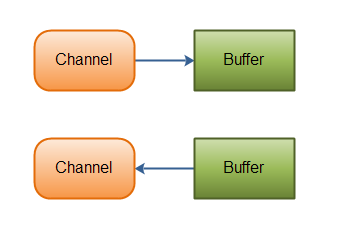Java NIO Channel
|
Jakob Jenkov |
Java NIO Channels are similar to streams with a few differences:
- You can both read and write to a Channels. Streams are typically one-way (read or write).
- Channels can be read and written asynchronously.
- Channels always read to, or write from, a Buffer.
NIO可读可写,流只能读或者写
Channel可以异步的读和写
Channel读到buffer,从buffer里写到Channel
As mentioned above, you read data from a channel into a buffer, and write data from a buffer into a channel. Here is an illustration of that:
 |
| Java NIO: Channels read data into Buffers, and Buffers write data into Channels |
Channel Implementations
Channel的一些实现类
Here are the most important Channel implementations in Java NIO:
- FileChannel
- DatagramChannel
- SocketChannel
- ServerSocketChannel
The FileChannel reads data from and to files.
The DatagramChannel can read and write data over the network via UDP.
The SocketChannel can read and write data over the network via TCP.
The ServerSocketChannel allows you to listen for incoming TCP connections, like a web server does. For each incoming connection a SocketChannel is created.
Basic Channel Example
一个Channel的例子
Here is a basic example that uses a FileChannel to read some data into a Buffer:
RandomAccessFile aFile = new RandomAccessFile("data/nio-data.txt", "rw");
FileChannel inChannel = aFile.getChannel();
ByteBuffer buf = ByteBuffer.allocate(48);
int bytesRead = inChannel.read(buf);
while (bytesRead != -1) {
System.out.println("Read " + bytesRead);
buf.flip();
while(buf.hasRemaining()){
System.out.print((char) buf.get());
}
buf.clear();
bytesRead = inChannel.read(buf);
}
aFile.close();
注意这个flip()方法,一开始你是读到buffer,然后调用flip(),变成从buffer里读东西出来。
Notice the buf.flip() call. First you read into a Buffer. Then you flip it. Then you read out of it. I'll get into more detail about that in the next text about Buffer's.



